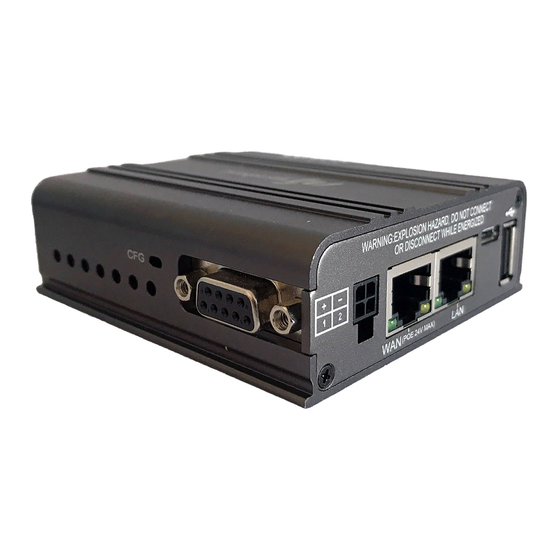
Subscribe to Our Youtube Channel
Summary of Contents for Microhard Systems pMDDL900
- Page 1 Operating Manual pMDDL900 2X2 MIMO 900MHz OEM DDL Module (1W) Revision 0.30, May 28, 2019 Microhard www.microhardcorp.com...
-
Page 2: Warranty
Warranty Microhard Systems Inc. warrants that each product will be free of defects in material and workmanship for a period of one (1) year for its products. The warranty commences on the date the product is shipped by Microhard Systems Inc. Microhard Systems Inc.’s sole liability and responsibility under this warranty is to repair or replace any product which is returned to it by the Buyer... - Page 3 WARNING: Changes or modifications not expressly approved by Microhard Systems Inc. could void the user’s authority to operate the equipment. This device has been tested with UFL to Reverse Polarity SMA connectors with the antennas listed in Appendix A When integrated in OEM products, fixed antennas require installation preventing end-users from replacing them with non-approved antennas.
- Page 4 3) EUT with 3 dBi dipole antenna co- located with LTE Data Module SARA-R410M ( FCC ID XPY2AGQN4NNN, IC 8595A-2AGQN4NNN) 4) EUT with 3 dBi dipole antenna co- located with LTE Data Module L850 LTE Module ( FCC ID ZMOL850GL, IC 21374-L850GL ) PMDDL900 Operating Manual...
-
Page 5: Table Of Contents
Contents Warranty ..................................ii Proprietary Rights ................................. ii pMDDL900 Regulatory Requirements ........................iii Co-Location Instructions ............................iiv GENERAL ................................1 ................................ 1 RODUCT VERVIEW ..............................2 UTPUT OWER EVEL INSTALLATION ..............................3 ..................................3 VERVIEW ............................3 STIMATING THE ARGIN .............................. -
Page 7: General
The small-size and superior RF performance of this module make it ideal for many applications. While a pair of pMDDL900 modules can link two terminal devices (“point- to-point” operation); multiple modules can be used together to create a network of various topologies, including “point-to-multipoint” and “repeater”... -
Page 8: Output Power Level
While the typical application for the pMDDL900 is to provide a short- to mid-range wireless communications link between DTEs, it can be adapted to almost any situation where an asynchronous serial interface is used and data intercommunication is required. -
Page 9: Installation
3. Installation 3.0 Overview The pMDDL900 complies with FCC part 15 at the modular level for operation in the license-free 902-928 MHz ISM band. This chapter provides guidelines for installing and deploying equipment which incorporates the pMDDL900 module. 3.1 Estimating the Gain Margin... - Page 10 These numbers are real averages taken from rural environments. They do not apply to urban, non-line-of-sight environments. Table 2 Path Loss Distance Base Height Mobile Height Path Loss (km) (dB) 116.5 110.9 124.1 117.7 135.3 128.9 116.2 109.6 122.4 128.8 pMDDL900 Operating Manual...
-
Page 11: Antennas And Cabling
-95dBm. 3.2 Antennas and Cabling This section describes the recommended procedure for installing cabling and antennas for use with the pMDDL900 module. 3.2.1 Internal Cabling The most common method for installing the module is to run a cable from the module’s UFL connector to a reverse TNC bulkhead connector on the chassis... -
Page 12: Installing External Cables, Antennas And Lightning Arrestors
Typically, both ports on surge any other antenna or transmitter. arrestors are N-female. External Filter Although the pMDDL900 is capable of filtering out RF noise in most WARNING: environments, there are circumstances that require external filtering. Direct human contact with the Paging towers and cellular base stations in close proximity to the pMDDL900 antenna can desensitize the receiver. - Page 13 Appendix A. antenna with appropriate gain. See appendix A for a list of approved antennas that can be used with the pMDDL900 radio modem. If you require another type of antenna WARNING: please contact Microhard Systems Inc. The pMDDL900 CANNOT be Be careful with dBi vs dBd gains used with any antenna that does not appear in Appendix A.
- Page 14 36dBm with respect to the isotropic radiator. Example 1) What is the maximum power the pMDDL900 can be set to comply with FCC and IC given the following equipment given a Rubber Ducky Ant Gain 2dBi and no cable or connectors in the system? Max EIRP 36dBm Max TX power = EIRP –...
- Page 15 WARNING: Changes or modifications not expressly approved by Microhard Systems Inc. could void the user’s authority to operate the equipment. This device has been tested with UFL connectors with the antennas listed in Appendix A When integrated in OEM products, fixed antennas require installation preventing end-users from replacing them with non-approved antennas.









Need help?
Do you have a question about the pMDDL900 and is the answer not in the manual?
Questions and answers